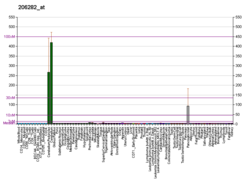Top Qs
Timeline
Chat
Perspective
NEUROD1
Protein-coding gene in the species Homo sapiens From Wikipedia, the free encyclopedia
Remove ads
Neurogenic differentiation 1 (Neurod1), also called β2,[5] is a transcription factor of the NeuroD-type. It is encoded by the human gene NEUROD1.
In mice, Neurod1 expression is first seen at embryonic day 12 (E12).[6]
It is a member of the Neurod family of basic helix-loop-helix (bHLH) transcription factors, composed of Neurod1, Neurod2, Neurod4, and Neurod6. The protein forms heterodimers with other bHLH proteins and activates transcription of genes that contain a specific DNA sequence known as the E-box. It regulates expression of the insulin gene, and mutations in this gene result in type II diabetes mellitus in mouse models and in human clinical patients.[7]
Neurod1 is found to convert reactive glial cells into functional neurons in the mouse brain in vivo[8] In the adult cortex, Neurod1 expression is a marker of mature excitatory pyramidal neurons in the upper-most layers of the cortex.[9]
Remove ads
Interactions
Neurod1 has been shown to interact with MAP3K10,[10] MAFA[11] and Cyclin D1.[12]
References
Further reading
External links
Wikiwand - on
Seamless Wikipedia browsing. On steroids.
Remove ads





